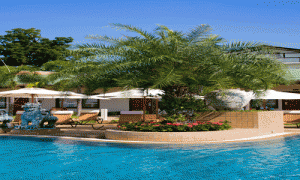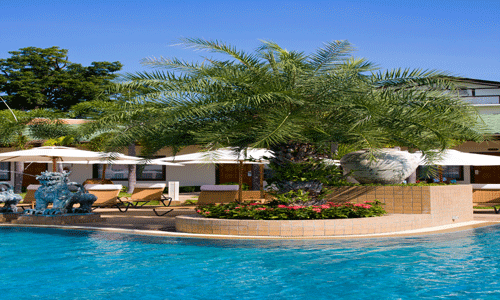 Track2Realty: The top six cities of India are expected to see a total of 50,000 new hotel rooms across categories in the next 5- 6 years. This is in response to the steady growth the hospitality sector has recorded over the last few years. 2012 alone is expected to see 14,800 fresh keys by the end of the year. Out of the total expected supply for 2012, 2000 new hotel rooms have already entered the market. These are the findings of a report by Cushman & Wakefield (C&W)and Confederation of Indian Industries (CII).
Track2Realty: The top six cities of India are expected to see a total of 50,000 new hotel rooms across categories in the next 5- 6 years. This is in response to the steady growth the hospitality sector has recorded over the last few years. 2012 alone is expected to see 14,800 fresh keys by the end of the year. Out of the total expected supply for 2012, 2000 new hotel rooms have already entered the market. These are the findings of a report by Cushman & Wakefield (C&W)and Confederation of Indian Industries (CII).
The report titled “Indian Hospitality Story 2012 & Beyond” at the 4th International CII Hospitality Fair- 2012 which was held today, Sept 20, in New Delhi. The report was released at the first day of the 3 – day exhibition by Honourable Minister of Tourism, Subodh Kant Sahai.
In this report Cushman & Wakefield evaluates the hospitality sector dynamics of top six cities of India – Bengaluru, Chennai, Delhi, Hyderabad, Kolkata and Mumbai and provides an overview on the performance, growth and outlook of the Indian Hospitality industry.
Akshay Kulkarni, Regional Director – Hospitality, South and South East Asia, Cushman & Wakefield, said, “India’s hospitality sector has been witnessing interest from a variety of segments ranging from – MICE, Wellness Tourism, Spiritual & Pilgrimage Tourism, apart from the traditional business or leisure travel. The demand has been strong from both foreign as well as domestic tourists. Given the rather diverse nature of demand, the hospitality industry is also looking at creating adequate products to service the varied tourist requirements. With the support and initiatives by the governments at various levels, the hospitality sector is moving towards comprehensive growth”
NCR, with a total room supply of 17,500 rooms, is expected to see the highest fresh hotel room supply in the next 5 years. Mumbai (10, 200) and Bangalore (9, 400) will also see significant addition to the existing inventories in the city. The addition of new inventory will be concentrated in the potential growth areas – especially around airports, commercial growth corridors, industrial corridors and SEZs. These micro markets emerged as a result of business centers that were created in these cities due to growth in IT/ITeS , trade and commerce.
| Hotel Supply ( No. of rooms) | |||
| City Wise | H1-2012 | H2-2012 | Upcoming |
| Bengaluru | 400 | 3,800 | 9,400 |
| Chennai | 160 | 2,200 | 5,150 |
| Hyderabad | 430 | 160 | 3,720 |
| Kolkata | 0 | 150 | 4,500 |
| Mumbai | 300 | 1,540 | 10,200 |
| NCR | 830 | 5,000 | 17,550 |
| Total | 2,120 | 12,850 | 50,520 |
Source: Cushman & Wakefield research
The top six cites witnessed an Average Occupancy of 58% with an Average Room Rate (ARR) of INR 5,400 in HI 2012. The current averages record a marginal decline of 4% in AOR and 5% in ARR over the average of 2011 (full year) performance. Chennai recorded the highest Average Occupancy Rates (AOR) of 64% for H1 2012, followed by Mumbai (61%) and Kolkata (60%). All the cities witnessed only a marginal drop in AOR when compared to the previous year 2011. Mumbai and Kolkata saw the maximum dip in AOR.
A decline in AOR in popular destinations was due a number of factors but primarily due to addition of supply in major cities in H1 2012. On the other hand, a moderate slowdown in global economies led many corporations to curtail travel, while individual travelers have also been cautious due to fiscal uncertainties. Some other factors that have obliquely contributed to lower AOR are the advancements in technologies which make real time correspondence faster, easier and more cost effective and increase connectivity that ensure lesser hours of stay per visit.
A corresponding decline in ARR was noticed as hotel’s tried to ensure occupancy even at a moderately lower cost. Healthy competition in many of the cities is leading hotels to create monetarily attractive packages for potential visitors.
In H1, 2012 Mumbai, recorded the highest ARR of INR 6,400, followed by NCR INR 6,280 and Bengaluru INR 4,915 . While Chennai and Hyderabad witnessed marginal increase in ARR, all other cities saw the rates as wither stable or softening over 2011.
| City Wise | Average Occupancy Rate | ||
| 2011 | H1-2012 | ||
| Bengaluru | 59% | 57% | |
| Chennai | 67% | 64% | |
| Hyderabad | 54% | 53% | |
| Kolkata | 66% | 60% | |
| Mumbai | 67% | 61% | |
| NCR | 63% | 58% | |
| Average/Total | 62% | 58% | |
Source: Cushman & Wakefield research
| City Wise | Average Room Rate | ||
| 2011 | H1-2012 | ||
| Bengaluru | 5,740 | 4,915 | |
| Chennai | 4,700 | 4,900 | |
| Hyderabad | 3,790 | 3,830 | |
| Kolkata | 4,900 | 4,770 | |
| Mumbai | 6,395 | 6,400 | |
| NCR | 6,555 | 6,280 | |
| Average/Total | 5,723 | 5,444 | |
Source: Cushman & Wakefield research
Akshay added, “Occupancy rates may see an upward trend in the second half of 2012 keeping ARRs steady. However, since there is a substantial supply that is expected to enter the market over the new few years, the pressure on occupancy rate and ARRs, will continue. The phasing of the new inventory and gradual growth in the demand for hotels will help keep the rates at modest levels across the country. However going forward we expect ARRs to improve in the next 12- 18 months on account of stability in economy and expected growth in tourism in India. Also with more and more international brands operating in the country, the market will move towards being more organized and standardization of process including cost per room night.”
CITY TRENDS
Bangalore
Bengaluru has a total inventory of 16,000 keys as of H1 2012,with organized segment comprising 68% of the total inventory. this organized sector, ,The city recorded a marginal decline in occupancy rate to 57%, over 2011 while average room revenues declined by 15% during the period as a few hotels that did become operational were primarily in the budget and midscale segments. AOR declined due to an increase in the total number of rooms in the city, while demand remained steady, the proliferation of mid scale hotels was largely responsible for a decline in the ARRs for the city in the first half of 2012.
Going forward, the city has a pipeline of supply of 9400 rooms over the next 5-6 years. Most of the hotels will be developed in the luxury, midscale and budget categories. As Bengaluru is primarily an IT/ITeS center for business travelers and a gateway to southern India for leisure travelers, this trend is substantiated.
Akshay Kulkarni said the second half of 2012, will see moderate increase in ARRs with the beginning of festival seasons and robust passenger arrivals as observed for the previous years. MICE is one of the strongest demand segment in Bengaluru, given the penetration of IT/ITeS in the city.
Chennai
Chennai recorded the highest occupancy levels amongst the top six cities at 64%. ARR in H1 2012 was recorded INR 4,900 recording an increase of approximately 4% over 2011. Being a manufacturing and industrial center, hotels in Chennai cater to many long stay guests. MICE is also a significant demand segment in the city as various automotive and pharmaceutical conferences are organized in the city. This is evident in the stable occupancy rates and room revenues.
The total inventory for the city is 6,187 hotel rooms in H1 2012 of which 92% belongs to the organized sector. The cities inventory had grown by almost 32% since 2008 till the half year of 2012. The impact of the economic downturn had delayed a few hotel projects during the last year with only 160 rooms delivered in H1 2012. However a number of projects have been revived with over 5000 room planned over the next 5-6 years.
The city is expected to see an increase of nearly 36% in luxury segment, followed by 20% in the midscale segment, 13% in the budget segment, 7% in the upper upscale, and 6% in upscale segment. Also it is expected to see a more competitive environment in the luxury segment with the introduction of a number of significant luxury properties.
Akshay Kulkarni said, “Given the demand segments, the average business traveler to the city is price sensitive. Many hotels that have been and are currently being developed are in the budget and midscale segments. However, Guindy and Marine Drive are the micro markets with an array of luxury hotels- existing and upcoming.. The hotels around the airport provide a good mix across all categories.”
Hyderabad
Hyderabad has been a sluggish market for hotel performance as it has been gripped by some internal disturbances that keep arising in the region. The occupancy levels experienced by hotels have been hovering around 53% in the first half of 2012. The trend is likely to continue till the government stimulates a positive sentiment around for business and leisure visitors.
Approximately 3,700 rooms are expected in the market in the next 5-6 years and of the total expected supply 6% will be for luxury, 25% in Upper Upscale, 16% in upscale, 33% in midscale and 20% in the budget segment.
Kolkata
Kolkata has a total hotel inventory of 3,900 rooms of which 72% is in the organised sector. The city has not seen many new hotel developments in the recent past. The occupancy level of the city has declined from 66% in 2011 to 60% in H1 2012.ARR however remained unaffected. This may be accorded to the fact that Kolkata now has better connectivity from many other locations of the country. The number of flights has increased over the past year enabling the business travelers to return the same day.
Kolkata is expected to see a total of 4,500 new keys in the next 5-6 years which would nearly double the present hotel room inventory. Out of the current upcoming supply, it is expected that Kolkata will experience an increase of 33% in the upscale category, followed by 29% in the luxury category, 22% in midscale, 13% in upper upscale and 3% in the budget segment.
Akshay Kulkarni said, “The restraint in hotel development activity is likely to change in the city and the projects which have been delayed due to various reasons will also be revived.”
Mumbai
Mumbai has a total inventory of 18, 500 rooms as of H1 2012, with organized segment comprising 76% of the total inventory.
With AOR of 61%, Mumbai recorded a decline of 6% in occupancy rate in H1 2012. ARR however, has remained stable. Mumbai being a perennial market for the hospitality sector, the market has been witnessing steady demand from both business as well as leisure travellers. However, due to addition of a few hotel rooms in the beginning of the year, AORs have declined.
A total of 10,200 keys are expected in the next 4 -5 years of which majority supply will be in the upscale segment, followed by midscale and luxury hotels.
Akshay Kulkarni said, “The last quarter of the year is the most productive quarter for Mumbai and recovers for the relatively slower months during Q2 and Q3. Also the city is expected to witness a pipeline of 10,200 keys in the organized segment in the next 4- 5 years and thus the pipeline indicates an equilibrium that will be achieved with hotels operating across all categories in the various micro markets”
NCR
The city witnessed a supply of approximately 800 rooms in H12012 while 5000 rooms expected in H2 2012. There has been a slowdown of 3% in AOR and 4% in ARR in H1 2012 over 2011. We expect this to continue for a short to midterm period due to substantial supply that is expected in the city. Despite this downward trends, the inherent demand of the city remains as it is a significant business center with the international airport, which records the highest number of arrivals across the country.
NCR’s hospitality market is substantially covered under seven main regions and in H1 2012, hotels in Noida have highest occupancy levels (65%), followed by Delhi (64%) and Gurgaon (61%). However, average room rates are the highest in the Delhi, followed by Gurgaon. Further it is expected that 25% of the total inventory will come from the midscale segment, followed by luxury (20%), upscale (18%), upper upscale (16%) and budget (10%).
Akshay Kulkarni said, “The city will see the maximum influx of inventory over the next 5-6 years, with 17,500 keys in the pipeline in the organized segment. Also the hospitality district near the international airport is perceived to be a game changer and the first of its kind development in the country.”





